NATURAL GEOECOSYSTEMS OF THE UPPER WESTERN BUG BASIN.
The Upper Western Bug Basin (UWBB) contributes to the gauging station in Kamianka-Buzka within the non-mountain densely populated part of Lviv region, Ukraine and has an area of 2 376 km2. A natural geoecosystem (NGES) is an ecological geospatial model of a real landscape, which represents genetic relations between the primary natural land cover (vegetation and soil) and its natural abiotic factors – landforms, parent rocks, and climate. The NGES concept is based on the notions of an ecosystem, of hierarchical spatial landscape units as geosystems, and of reconstructed (potential) natural vegetation. Manual interpretation of topographic data, geological maps representing parent rock material, as well as of non-spatial ecological information (both published and collected in the field) allowed to distinguish seven classes of natural macro-ecochores – local NGES, which are delineated based on the mesorelief landform associations. The macro-ecochores of dissected interfluves were additionally fragmented into microecochores – local NGES commensurable with separate mesorelief landforms – using rule-based classification of topographic variables derived from the Shuttle Radar Topography Mission data. The micro-ecochores represent four topographic positions: 1) gentle concave and foot slopes, 2) flat watershed surfaces and rolling concave slopes, 3) convex watershed surfaces and rolling straight-convex slopes, and 4) steep slopes (concave-convex). Also, 12 individual micro-ecoregions were delineated and aggregated into three meso-ecoregions based on the morphostructural landforms. Areas and some landscape metrics indices were calculated for the ecoregions and the ecochores. As a result, three geo-datasets of the 1:50,000 scale accuracy were created for the UWBB: 1) of natural macro-ecochores (polygons), 2) of natural macro- and micro-ecochores (raster), and 3) of meso- and micro-ecoregions (polygons). Natural ecochores of mesic mesotrophic and eutrophic pedunculate oak and European beech forests with grey forest soil are located on medium and high interfluves covered with loess-like loam, primary natural hydromesic oligotrophic oak-Scotts pine forests on soddy slightly podzolised soil occupy sandy low interfluves and alluvial terraces, while natural black alder formations prevail on alluvial and boggy soils in the valley bottoms of smaller streams and on the river flood plains. Among the micro-ecoregions, oak forests of wavy loess plains occupy the largest portion of the UWBB.
Key words: ecochore, ecoregion, landform, natural soil, natural vegetation, landscape metrics.
References:
- Derzhavna geologichna karta Ukrayiny`, m-b 1:200000. Voly`no-Podil`s`ka seriya M-34-XVIII (Rava-Rus`ka), M-35-XIII (Chervonograd), M-35-XIX (L`viv) / S. Gerasimov, S.V. Chaly`j, A.A. Plotnikov, I.I. Gerasimova, G.V. Polkunova, I.O. Kosty`k, T.L. Yevtushko. – Ky`yiv, 2004. – 120 s.
- Kruglov I. Landshaft yak geoekosy`stema / I. Kruglov // Visny`k L`viv. un-tu. Seriya geogr. – 2006. – Vy`p. 33. – S. 186–193.
- Kruglov I. Delimitaciya, metry`zaciya ta klasy`fikaciya morfogenny`x ekoregioniv Ukrayins`ky`x Karpat / Kruglov // Ukr. geogr. zhurn. – 2008. – # 3. – S. 59–68.
- Karta gruntiv Ukrayins`koyi RSR masshtabu 1:200000. Ly`st # 49 / K. Krups`ky`j [ta in.]. – Ky`yiv: Ukrzemproekt, 1967.
- Kurganevy`ch L.P. Umovy` formuvannya ta chy`nny`ky` vply`vu na vodny`j rezhy`m richky` Poltva / P. Kurganevy`ch, M.Z. Shipka // Visny`k L`viv. un-tu. Seriya geogr. – Vy`p. 40. – S. 52-59.
- Miller G.P. Landshaftoznavstvo: teoriya i prakty`ka: Navch. posibn. / P. Miller, V.M. Petlin, A.V. Mel`ny`k. – L`viv: Vy`dav. centr LNU im. I. Franka, 2002. – 172 s.
- Muxa B.P. Landshaftna karta L`vivs`koyi oblasti masshtabu 1:200 000 / P. Muxa // Visny`k L`viv un-tu. Seriya geogr. – 2003. – Vy`p. 29. – S. 58–65.
- Nakonechny`j Yu.I. G`runty` zaplavy` riky` Zaxidny`j Bug / I. Nakonechny`j, S.P. Poznyak. – L`viv: Vy`dav. centr LNU im. I. Franka, 2011. – 220 s.
- Pry`roda L`vivs`koyi oblasti / I. Gerenchuk [ta in.]. – L`viv: Vy`d-vo L`viv. un-tu, 1972. – 192 s.
- Association Agreement between the European Union and its Member States, of the one part, and Ukraine, of the other part. [Electronic resource]. – Rezhy`m dostupu: http://eeas.europa.eu/delegations/ukraine/eu_ukraine/ association_agreement/ index_en.htm (data zvernennya: 17.09.2015).
- Brussard P.F. Ecosystem management: what is it really? / F. Brussard, J.M. Reed, C.R. Tracy // Landscape and Urban Planning. – 1998. – Vol. 40. – P. 9–20.
- Chang K. Introduction to geographic information systems with data set CD-ROM. 7th edition / Chang. – No place: McGraw-Hill, 2013. – 425 p.
- Ecosystem management programme: a new approach to systainability. – Nairobi: UNEP, 2009. – 24 p.
- Environmental Earth Sciences. Journal / Springer – 2011. – Vol. 65. – Issue 5. – P. 1363–1599.
- Environmental Earth Sciences. Journal / Springer – 2014. – Vol. 72. – Issue 12. – P. 4673–4971.
- Jarvis A. Hole-filled SRTM for the globe Version 4 available from the CGIAR-CSI SRTM 90 m Database. – 2008. [Electronic resource] / Jarvis, H.I. Reuter, A. Nelson, E. Guevara. – Rezhy`m dostupu: http://srtm.csi.cgiar.org (data zvernennya: 17.09.2008).
- Kuemmerle T. Cross-border comparison of land cover and landscape pattern in Eastern Europe using a hybrid classification technique / Kuemmerle, V.C. Radeloff, K. Perzanowski, P. Hostert // Remote Sensing of Environment. – 2006. – Vol. 103. – P. 449–464.
- Moravec J. Reconstructed natural versus potential natural vegetation in vegetation mapping: A discussion of concepts / Moravec // Appl. Veg. Sci. – 1998. – No 1. – P. 173–176.
- Zerbe S. Potential natural vegetation: Validity and applicability in landscape planning and nature conservation. / Zerbe // Appl. Veg. Sci. – 1998. – No 1. – P. 165–172.
